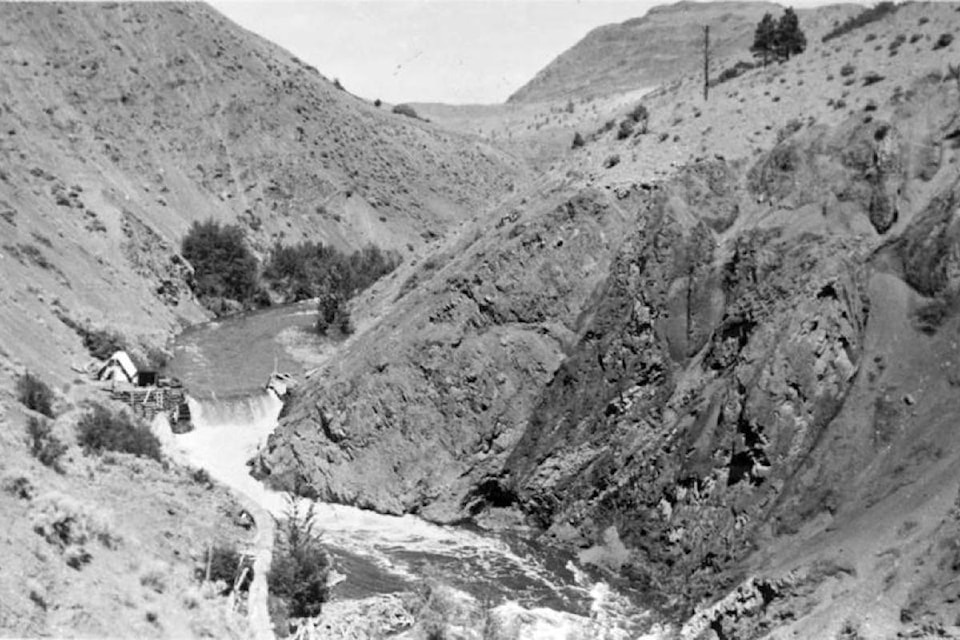Hundreds of feet below Highway 97C as it winds through the bluffs northwest of Ashcroft is an almost forgotten piece of the town’s history, one that few people know of and fewer have seen firsthand. Viewing what remains of it involves a difficult and dangerous scramble along the steep banks of the Bonaparte River, meaning that since it closed down, more birds than people have probably viewed the former site of the Ashcroft Water Works and the Ashcroft Water, Light, and Power Company.
It was in 1897 that plans for both outfits were first floated, in order to bring a reliable source of water to Ashcroft’s homes and businesses and create and supply electricity. At that time the population of Ashcroft was around 500, excluding the Chinese residents, who probably numbered half as many again. The town was an important transportation hub, with a multitude of businesses to fill the needs of residents, visitors, and those passing through to points north and east.
It was also, in 1897, actively promoting itself as part of the inland (or “poor man’s”) route to the goldfields in the north. A water supply, and electricity, were seen as essential components of the town, and in late December 1897 a group of businessmen met to discuss the idea.
It was not greeted with the enthusiasm they might have expected. “The project was not favourably entertained and the water works are in a condition of status quo at present,” noted an article in the Journal on Dec. 25, 1897. “What the final result will be can not yet be told. Water is badly needed and a plant costing a moderate amount would pay well. It is to be hoped that some arrangement will be made whereby the work will go ahead.”
Either that initial meeting caught everyone in a bad mood, or the people behind the scheme did some persuasive talking, because on Jan. 15, 1898 the paper ran a story headlined “Good News For Ashcroft”. It stated that “The water works and electric light company have begun active work at Harper’s Mill [at the mouth of the Bonaparte] and have all machinery, lumber, etc. ordered for a first class plant and if the weather is favourable ninety days from now will see this deserving project well along towards completion.”
The story explained that power would come from the Bonaparte, and a large-capacity pump would fill a reservoir on a hillside 200 feet above Ashcroft. The water would be supplied to houses and businesses at “as cheap rates as can be afforded”, and would provide fire protection to the town via a series of hydrants. Electric light would also be provided to all the houses and businesses that wanted it, “at the same rate that it is now supplied in large cities, and will be but little more than one half the cost of coal oil.” The article finished on a hopeful note: “Now look out for Ashcroft to grow.”
The idea of having water cheaply and easily available by simply turning on a tap was a great convenience. Electricity, however, was something else altogether, and a relatively recent innovation. The first electric light bulb had been invented in 1872; Vancouver did not see its first electric lights until 1887; and it is estimated that the majority of homes in Canada did not have electricity until well into the 20th century. Yet little more than a decade after Vancouver, Ashcroftonians were being told that electric lights would be available to all who wanted them.
Whatever doubts people might have had when the plan was first proposed, the town was quick to get behind the idea. The June 4, 1898 issue of the Journal asked “Who will recognize Ashcroft with the best system of lights and water in the province? Watch us set out shade trees and grass!” In the July 2, 1898 issue it was reported that “Many houses and business places are now wired for the electric lights and within the next thirty days the electric current will be turned on. The water will follow within a couple of weeks thereafter and it will be one of the best systems of light and water in Canada.”
By Aug. 6 readers were told that “Most of the business houses, hotels, etc., are wired and the lamps in place and also many of the private houses. When Ashcroft has a plentiful supply of water and an efficient lighting service it will be a much pleasanter place to live in. In the course of a year or so we predict it will be one of the brightest, busiest little towns in Canada. We will then have a glorious climate, healthy situation, good water, and fruitful soil. What more can we wish for?”
Next time: Water and electricity come to Ashcroft, and what it took to get them there.
editorial@accjournal.ca
Like us on Facebook and follow us on Twitter
